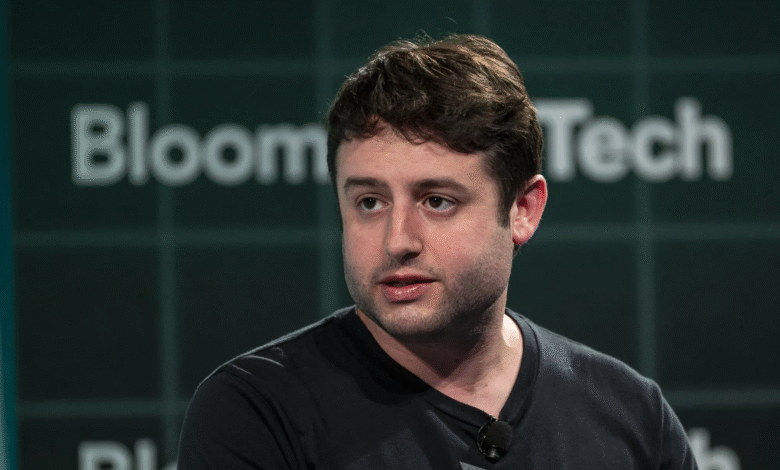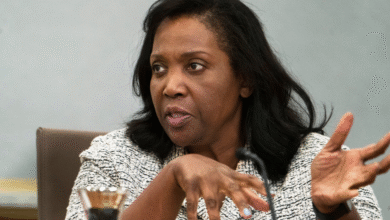Dylan Field’s Journey from Dropout to Tech Billionaire

Dylan Field, the visionary CEO of Figma, has made headlines recently as his design startup soared on the NYSE, placing him firmly in the billionaire bracket. At just 33 years old, Field’s impressive rise from a college dropout at Brown University to a celebrated tech entrepreneur is nothing short of remarkable. His journey began with the prestigious Thiel Fellowship, a program that cultivates innovative thinkers who dare to step away from traditional education to pursue groundbreaking ideas. With a net worth now exceeding $6.6 billion, Field exemplifies the potential of web-based design tools to revolutionize how teams collaborate on projects. His story resonates deeply within the tech community, inspiring other aspiring entrepreneurs to follow a similar path toward success in the fast-paced digital landscape.
Introducing Dylan Field, the brilliant mind behind Figma, we delve into the inspiring narrative of this college dropout turned tech billionaire. This young entrepreneur’s extraordinary success is amplified by his background as a Thiel Fellow, where innovative ideas are fostered outside of traditional academic settings. Field’s development of leading web-based design solutions sets him apart in the tech industry, positioning him as a significant player amid competition. As we explore his rise to prominence, we uncover the lessons learned and challenges faced along the way, painting a comprehensive picture of a modern trailblazer in the world of technology.
Dylan Field: From College Dropout to CEO
Dylan Field’s story is an inspiring tale for aspiring entrepreneurs around the globe. Dropping out of Brown University, he seized the opportunity to join the Thiel Fellowship, a program founded by Peter Thiel that encourages young innovators to pursue their dreams outside the traditional educational path. This bold decision was pivotal in shaping Field’s future, allowing him to focus all his energy on building Figma without the constraints of academia.
The Thiel Fellowship provided Field with more than just financial support; it offered a network of like-minded individuals and mentorship opportunities that would prove invaluable in the highly competitive tech landscape. By forgoing a conventional degree, Field positioned himself amongst a select group of tech entrepreneurs who sought to disrupt the status quo and innovate in ways that traditional educational paths may not have allowed.
The Thiel Fellowship: A Launchpad for Innovation
The Thiel Fellowship has been a launchpad for numerous tech entrepreneurs, offering young innovators the chance to receive funding while they pursue groundbreaking ideas. Field was among the second cohort of fellows, which underscored the fellowship’s role in nurturing talent outside of the classroom setting. This environment fosters creativity and pushes fellows to create revolutionary designs, ultimately contributing to the tech ecosystem with products such as Figma.
The program has cultivated a culture of innovation by bringing together ambitious individuals who share a common goal of changing the world through technology. As more graduates of the Thiel Fellowship enter the job market as billionaires or influential leaders, it’s becoming clear that unconventional path is yielding remarkable results, as illustrated by Dylan Field’s remarkable ascent in the tech industry.
Field’s rise within this innovative network aligns perfectly with the rising trend of tech entrepreneurs who prioritize practical experience over traditional education. This mindset is reshaping the narrative around success in Silicon Valley, where the emphasis is increasingly on what one can create rather than where one attended school.
Figma: Revolutionizing Web-Based Design Tools
Figma has established itself as a leader in web-based design tools, particularly during the pandemic. The platform’s focus on collaboration and real-time design has transformed how teams interact and create together. From enabling multiple users to work seamlessly on projects to incorporating feedback mechanics, Figma’s tools have significantly changed the landscape of design and user experience.
Innovation in web-based design is crucial as businesses adapt to a more digital-centric world. Figma’s introduction of tools like FigJam has not only enhanced user engagement but has also provided a fun and interactive environment for brainstorming and collaboration. This emphasis on adaptability has made Figma a preferred choice for designers and teams, solidifying its presence in the marketplace compared to traditional competitors.
Dylan Field’s Adaptability and Vision
Dylan Field’s adaptability has been a significant factor in the success of Figma. His ability to pivot from a drone software focus to web-based design tools was a testament to his visionary thinking and foresight. This shift responded directly to market demands, allowing Figma to fill a gap in collaborative design solutions that became especially vital during the pandemic.
Field’s openness to feedback and willingness to listen to his team has fostered a collaborative culture within Figma. This has resulted in continuous improvement and innovative product launches that resonate with users’ needs, solidifying Figma’s market position and appeal. His leadership style represents a modern approach to entrepreneurship, one that values team dynamics and customer-centric development.
Facing Competition: Challenges and Triumphs
Navigating through fierce competition, particularly from established giants like Adobe, has been a defining characteristic of Field’s journey. The initial intent for Adobe to acquire Figma for $20 billion highlighted the platform’s immense value and potential but also illustrated the significant challenges that come with such ambitious aspirations.
Despite these hurdles, Field and his team have continued to press forward, launching innovative products that leverage Figma’s unique position in the design world. Countering Adobe’s influence required not just resilience but a strategic approach to product development that differentiates Figma in a saturated market, making it a go-to tool for collaborative design.
Humility and Leadership in Tech Entrepreneurship
Dylan Field’s humility is a notable aspect of his leadership style, setting him apart from many other tech billionaires. Acknowledged by peers like Joshua Browder as the ‘most humble billionaire’, Field’s character contributes not just to his corporate culture but to the larger narrative of tech entrepreneurship that often glorifies cutthroat competitiveness.
This humility has fostered strong relationships within his team and with his fellow innovators. The ability to remain grounded, even while reaching billionaire status, speaks volumes about Field’s values, showing that leadership in tech can also combine ethical stewardship with aggressive innovation.
The Future of Figma and Digital Design
Looking into the future, Figma is poised to continue its trajectory of growth and influence in the digital design space. Given the ongoing trends toward remote work and online collaboration, the demand for web-based design tools remains high. Field’s commitment to innovation suggests that Figma will continue to expand its offerings, keeping pace with the evolving needs of designers worldwide.
Additionally, with the rise of design thinking and user experience as essential components in product development, Figma’s role in this ecosystem is likely to grow. This presents not just opportunities for Field but also positions Figma as a thought leader in shaping how design integrates seamlessly into product development.
Dylan Field’s Contribution to the Tech Landscape
Dylan Field’s contributions to the tech landscape extend beyond his role at Figma. As a Thiel Fellow and successful tech entrepreneur, he represents a new generation of innovators who prioritize collaboration and community-driven approaches in their work. Field’s story exemplifies how thinking outside traditional academic pathways can lead to groundbreaking achievements.
His influence resonates in startup incubators and among aspiring tech entrepreneurs who look to Field’s journey as evidence that success can stem from creative risks and innovative thinking. In this evolving tech landscape, figures like Field encourage others to harness their talents and pursue unique avenues for success, paving the way for the next wave of tech advancements.
Conclusion: The Legacy of a College Dropout Billionaire
As Dylan Field continues to impact the tech industry, his legacy as a college dropout billionaire offers inspiration to many. His path highlights the potential for success outside traditional educational frameworks, encouraging future innovators to take the leap like he did. The story of Field emphasizes that ambition, adaptability, and collaboration are pivotal traits for any aspiring entrepreneur.
The rise of Figma under Field’s leadership marks a significant achievement in the world of tech startups and shows how visionaries can reshape entire industries. The combination of Field’s humility, strategic thinking, and commitment to innovation will undoubtedly influence future eras in tech entrepreneurship for years to come.
Frequently Asked Questions
What is Dylan Field’s background as a Figma CEO and college dropout billionaire?
Dylan Field, the co-founder and CEO of Figma, is a remarkable tech entrepreneur who dropped out of Brown University to pursue the Thiel Fellowship. This program provides funding to young innovators. His journey reflects the path of many successful tech entrepreneurs who prioritize real-world experience over traditional education.
How did the Thiel Fellowship influence Dylan Field’s career as a tech entrepreneur?
The Thiel Fellowship significantly impacted Dylan Field’s career by allowing him to focus on building Figma without the constraints of traditional education. Receiving $100,000 as part of the fellowship helped him turn his ideas into reality, showcasing the value of the program for young tech entrepreneurs.
What are some notable achievements of Dylan Field as the CEO of Figma?
As Figma CEO, Dylan Field led the company to a successful debut on the NYSE, tripling its stock price on the first day. His leadership has helped Figma become a leading web-based design tool, expanding its product offerings and firmly establishing its market presence.
Why is Dylan Field compared to other college dropout billionaires like Mark Zuckerberg?
Dylan Field is often compared to Mark Zuckerberg due to their similar backgrounds as college dropouts who became successful tech billionaires. Both have ties to Peter Thiel and share a focus on innovation and entrepreneurship, illustrating the potential for success outside traditional academic paths.
What impact did Figma’s design tools have during the pandemic under Dylan Field’s leadership?
Under Dylan Field’s leadership, Figma’s web-based design tools became essential during the pandemic, facilitating collaboration among remote teams. The adaptability and innovative approach to design showcased by Field and his team significantly contributed to Figma’s growth and relevance in the tech industry.
How did Dylan Field’s approach differ from Steve Jobs in building Figma?
Unlike Steve Jobs, Dylan Field is often described as the ‘anti-Steve Jobs’ due to his humble demeanor and collaborative leadership style. He emphasizes team feedback and adaptability, which has been crucial in Figma’s success as a leading web-based design tool.
What challenges did Dylan Field face in his role as Figma CEO, especially regarding competition?
Dylan Field faced significant challenges in competing with Adobe, particularly when a proposed acquisition deal fell through due to regulatory issues. However, by launching innovative products like FigJam and a free design editor, he successfully strengthened Figma’s market position against corporate giants.
What can aspiring tech entrepreneurs learn from Dylan Field’s journey as a college dropout billionaire?
Aspiring tech entrepreneurs can learn from Dylan Field’s journey that taking risks, embracing innovation, and valuing collaboration are key to success. His experience shows that a non-traditional path can lead to significant achievements and that adaptability is crucial in the fast-paced tech environment.
| Key Points | Details |
|---|---|
| Dylan Field’s Background | Dropped out of Brown University and joined the Thiel Fellowship. |
| Figma’s Success | Figma’s stock tripled on NYSE debut, valuing Field’s stake at $6.6 billion. |
| Comparison with Mark Zuckerberg | Both have Thiel connections and are known for their startup journeys. |
| Humility in Leadership | Peers describe Field as a humble billionaire, contrasting with typical industry stereotypes. |
| Adaptability and Collaboration | Figma’s tools focused on collaboration, vital during the pandemic. |
| Challenges Faced | Field dealt with competition from Adobe and navigated regulatory issues affecting a $20 billion acquisition. |
Summary
Dylan Field’s remarkable journey from a college dropout receiving a Thiel Fellowship to amassing a fortune as a tech billionaire highlights the power of innovation, creativity, and collaboration in the tech industry. Despite the challenges he faced, including competition from giants like Adobe, his focus on adaptability and feedback has allowed Figma to thrive in a rapidly changing environment. This story not only inspires aspiring entrepreneurs but also serves as a testament to the value of humility and resilience in the pursuit of success.




